Axway Amplify provides both the SaaS-based Unified Catalog that is a part of the Amplify platform management layer (widely known as Amplify Central) and a CMS-based consumer-facing API Portal that can be deployed fully on-premises.

The API Portal is a client to the Unified Catalog and API Manager (Enterprise Edge Gateway), giving customers flexibility in their API architecture to meet specific branding, security, data residency, and other business needs. We briefly describe the capabilities below.
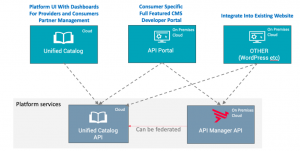
The Unified Catalog
The Unified Catalog caters to both providers and consumers of the integration assets, which can range from APIs and events to Managed File Transfer flows. Amplify’s management layer (also known as Amplify Central) manages multiple gateway environments that feed the Unified Catalog service.
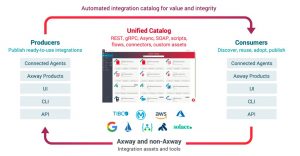
These gateways can be from Axway, such as API Manager (Enterprise Edge Gateway), or another vendor, such as AWS. These environments can also be repositories such as GitHub, Swagger Hub, or a competitor such as MuleSoft. APIs managed in these environments can be shared in the Unified Catalog.
Capabilities of the Unified Catalog include
- Automated discovery and management, enabling you to ensure the integrity of the catalog.
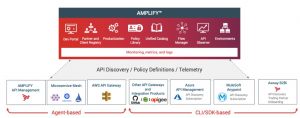
- Event-driven subscriptions allowing each environment or individual API to have their own customized subscription flow.
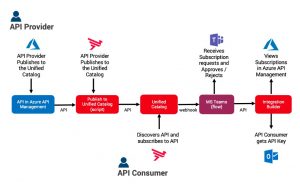
- Customized documentation for each API via markdown.
- Selective sharing of integration assets with teams and users.

- Management of the apps that consume the APIs or other integration assets.
- Tagging, categorization, search, and filtering.
- Measuring the popularity of an asset by views, subscriptions, and transactions.

The API Portal
The API Portal is primarily a consumer-facing application built on top of the open-source Joomla content management system. It’s available fully on-premises and can also be deployed in the cloud.
Capabilities of API Portal include:
- All the standard functionality you would expect from a CMS, such as articles, menus, pages with static and dynamic content, on-screen display configuration, themes, templates, styling, internationalization, and access control options – all from a single secure web-based administrative interface.
- Leveraging the open Joomla extensions directory to add further capabilities beyond what is provided out of the box.
- Acting as a client of the APIs from API Manager (Enterprise Edge Gateway) and Unified Catalog service to acquire all the necessary data to render the API and application catalogs, monitoring data, subscriptions, and user and authentication data.
- Enabling API consumers to browse, search, and filter the catalogs to find and subscribe to APIs of interest, and generate security credentials required to invoke and test the APIs, either by using the web-based Try-it function or by copying the portal generated code.
See also: API Catalog vs. API Marketplace: Finding the Digital Balance
FAQs
What is available with an Amplify subscription?
When you purchase an Amplify subscription, you are automatically entitled to the capabilities in the Amplify management layer (Central). This includes things like Environment Management, Unified Catalog, and API Observability.
This entitles you to the capabilities in the Unified Catalog automatically. You want you to be able to gain visibility and control quickly and automatically over all your integration assets.
The API Portal with CMS capabilities is available as an add on.
I have a traditional API Management license today. What additional capabilities are available in the Amplify subscription?
When you upgrade your traditional API Management license to an Amplify subscription, you have more than traditional API Management; you have an API platform that can simplify the complexity of distributed and hybrid architectures and accelerate delivery of business capabilities.
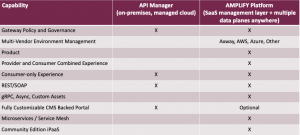
When you buy AMPLIFY, you can easily add on and exercise multiple integration use cases through a single experience.
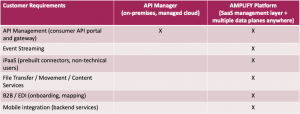
What are the business benefits I receive when I upgrade?
- Centralize control over all your gateways and integration asset, while allowing each business unit to operate autonomously to increase the speed of delivery.
- Increase the speed of integration and innovation by self-service enabling your organizations to find, integrate, and build new business services.
- Hybrid development and deployment enable both cloud and on-premises development with low-code tooling.
When would I add on an API Portal to the Amplify subscription?
- When you need a fully on-premises API Portal.
- When you need a CMS system to back their API Portal with features like Blogs, Forums, and others.
- When you want to have targeted branding per consumer segmentation.
- When you have region and data residency requirements and need separate APIM implementation for certain APIs.
What asset types beyond REST are supported with “API Management” like capabilities in Amplify’s Unified Catalog?

Watch the video to learn how to show APIs from the Amplify Unified Catalog.


